Category: Hunting Blog
Managing Timber Harvest With Future Deer Hunts in Mind
We recently worked on a property in Northern Missouri. The landowner had portions of the property logged a few years ago. Critters are spending lots of time in those areas, but there are several things we needed to change. We made several changes to the current management system, and will change the way timber is harvested from this property in the future! You can view this entire management plan on a future episode of GrowingDeer!
Keeping Tabs On Toms: Trail Cameras
It may seem early, but we’re already keeping tabs on these toms! This interior road is often walked by toms during the spring, as they move up and down the ridge. This string of longbeards is keeping to the pattern of years past. Trail cameras are great tools for learning turkey movements (scouting) during the spring then hunting these patterns once the season opens!
The Best Places to Hunt for Shed Antlers
It’s that time of the year! Antlers are hitting the ground but where should you start looking?
A great place to start searching is near food and cover.
Here at The Proving Grounds, the Fall Buffalo Blend is providing great late season forage for deer and we have found several sheds in food plots. Intern Nigel Waring recently found this nice shed in a plot while working in the field.
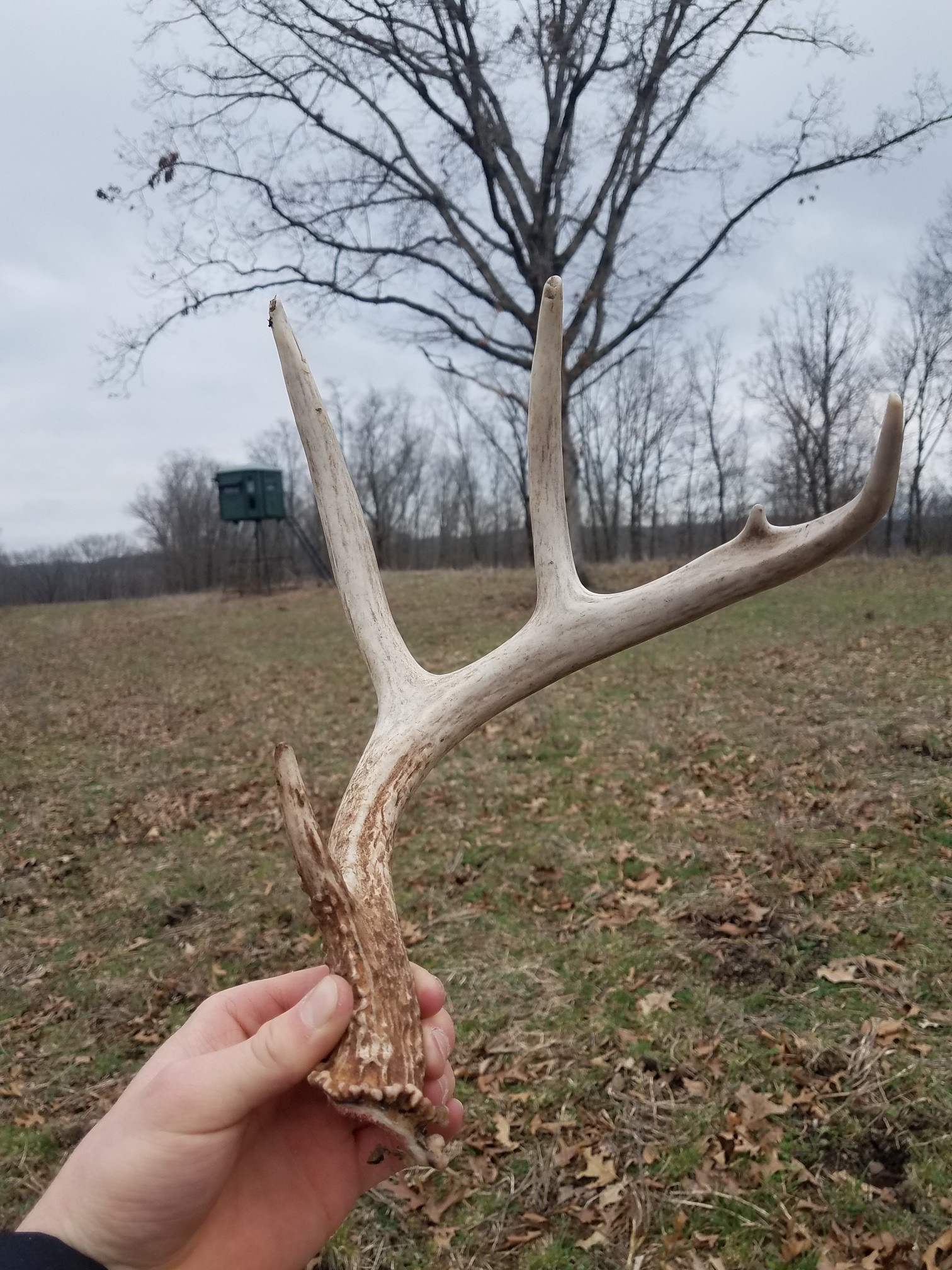
Clay recently found a shed in northwest Kansas while touring a property. There was no quality food for deer on this property. Clay found this shed near cover. Deer on this property were spending more time in cover and surviving on native forage.
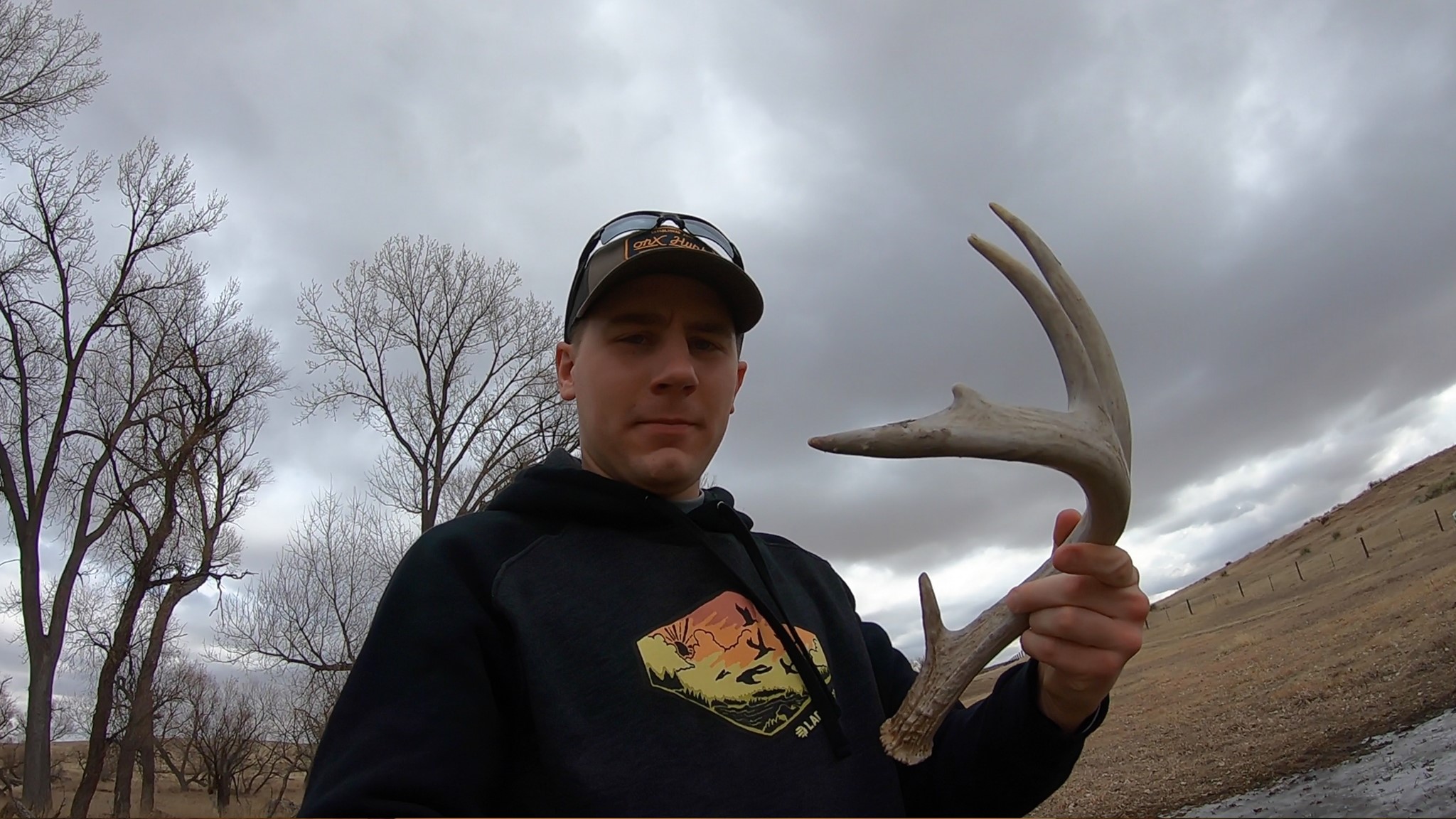
Tracy frequently has success hunting along known travel corridors and deer trails – especially when the trail is marked by a rub line! The antler below was found in just this scenario.
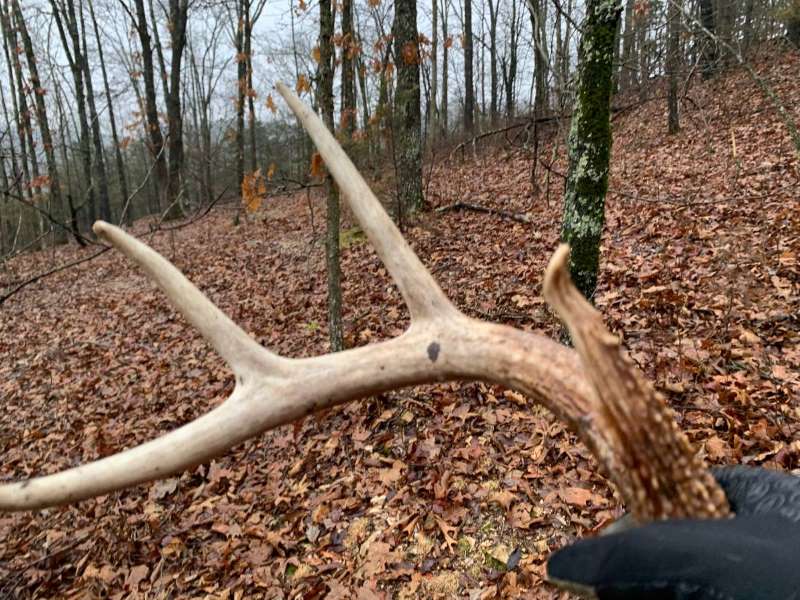
Deer trails marked with rubs leading to or in bedding areas are an especially good spot to slow down to search for antlers. The same trail where the above antler was found leads to a power line right-of-way. There were deer beds throughout that area in the native grass. The antler below was found along a trail cutting through that area.
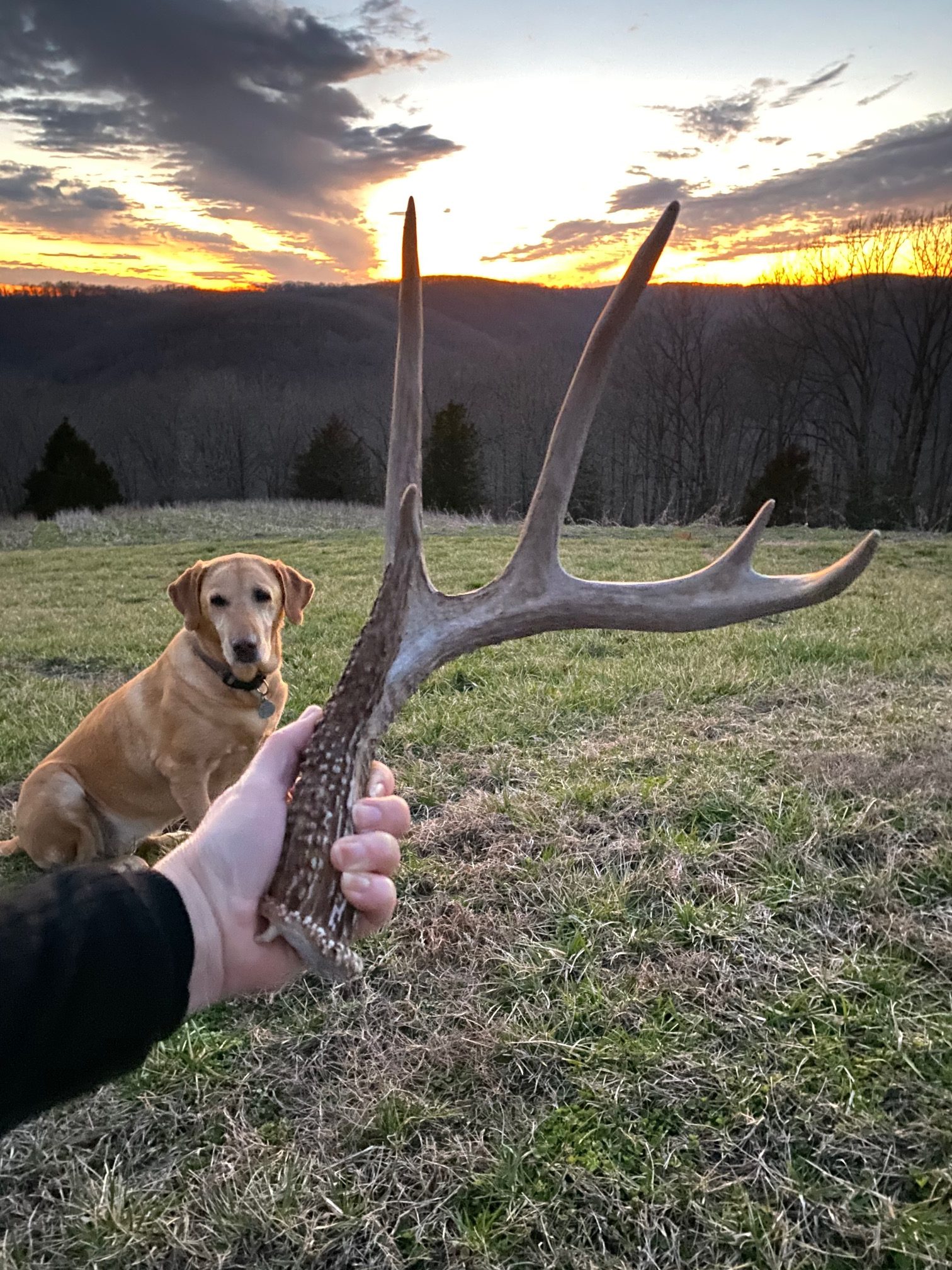
When in the searching in the timber for antlers, Tracy gives special attention when she finds an area where the deer have been bedding. The below video shares one of the first finds for the 2020 shed hunting season that was near where deer had been bedding in the timber.
No matter where you shed hunt, identify the best resource in the area this time of the year and start hunting there. It maybe food, cover or both. These are the first places to start and can yield “easy” finds. The next place to look would be travel corridors between food and cover.
When There’s Skull Attached to Shed Antlers
Below you will see a photo of an antler intern Nigel Waring found while creating a fire break.
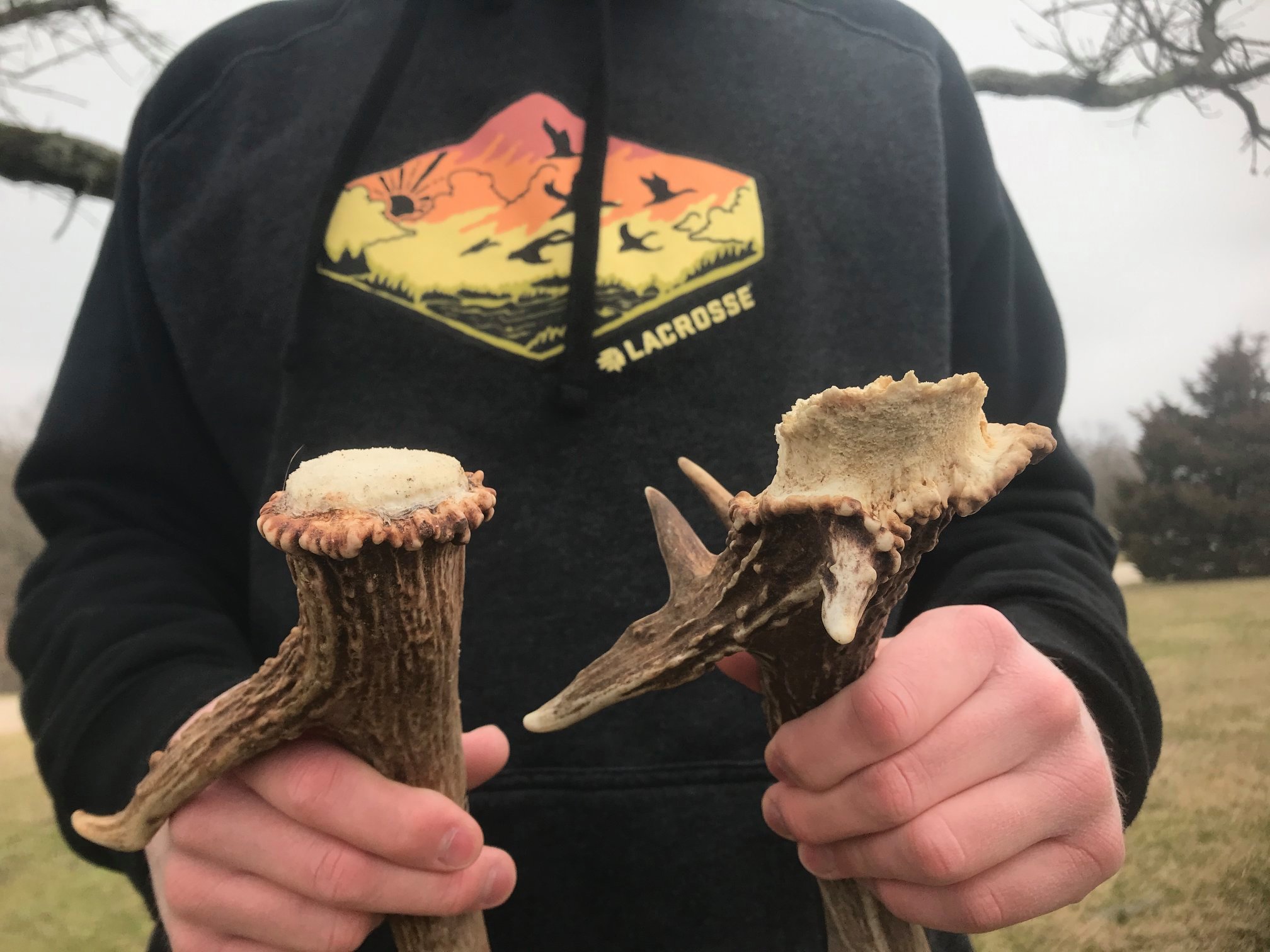
Unfortunately, this antler (shown right) has a large portion of the skull attached to the base. The antler was likely not “shed”, but broken off while sparring, rubbing or during another activity recently. This was most likely caused by an infection that eroded the skull and became a brain abscess. We suspect this buck has expired from the brain abscess due to the amount of bone found on the antler.
Antlers are shed as a response to chemical changes within a buck’s body. These changes are generally stimulated by changes in the amount of time the sun shines daily. However, within this window, several factors such as available nutrition, general health, and dominance ranking can determine when an individual buck sheds his antlers. For example, deer researchers often mention observing two dominate bucks in captivity fighting during this time of year. The loser will shed his antlers soon (sometimes the next day). It seems hard to imagine that antlers will simply fall off one day due to a change in dominance status (along with hormone levels) but these examples seem to indicate that’s the case. Never underestimate the effects of hormones on all critters!
Antlers for most bucks tend to be shed during the late winter months. However, some bucks will shed earlier due to other factors. Generally speaking, the healthier the herd, the longer bucks will hold their antlers! I like seeing some bucks with antler during Missouri’s turkey season! Bucks healthy enough to hold antlers that late into the winter are an excellent indicator of a healthy deer herd. It also indicates that the habitat is likely good for turkeys also!
The antler shown on the left is one that shed clean and is rounded at the base. Based on these characteristics, this buck (left shed) was likely very healthy when he shed the antler. You can learn a lot by studying antlers/sheds!
To learn more about brain abscesses, watch the next episode coming up Monday on GrowingDeer!
Where are the Deer? Look for the Limited Resource
I recently received a question from a hunter that wondered why mature bucks weren’t staying on his property. He described his property as 168 acres in central Michigan. There are about 27 acres of corn each year and 6 different small ¼ to 2 acre sized plots planted in various food plot blends.
The property includes 70 acres of hardwoods, mostly maple, and not many oaks. There are lots of apple trees spread around the property. There is a sanctuary area of about 20 acres and there seems to be lots of resident does and fawns.
I shared with the him that buck home range size varies based on the quality of habitat and many other factors. Based on lots of research throughout the whitetail’s range it is common for bucks to have a home range of more than 640 acres (a square mile).
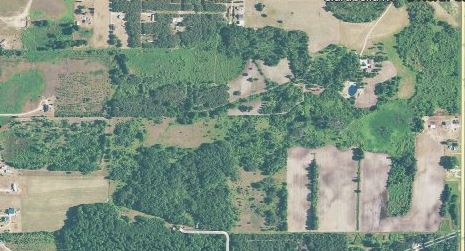
A very important consideration to determine why bucks may not be spending more time on the property is what resources are available there versus on the neighboring properties during the hunting season. This could be as simple as where standing corn is located and, just as importantly, where the hunting pressure is the lowest. A 20-acre sanctuary equals 1/8th of the property. If deer have to run a gauntlet of hunting pressure to get to the sanctuary or human scent frequently blows through most of the sanctuary then deer will likely seek cover elsewhere.
So – if this property is in the middle of a heavily timbered area I suspect that food plots would be a major attraction – a limited resource. If the property is surrounded by similar habitat with ample quality forage readily available, then hunting pressure/security cover may be the most limiting factor and where bucks spend most of their time during daylight.
I always consider what deer need then work to ensure that the most limited resource (food, cover, water, security) is available where I can hunt. Taking time to determine which resources are available where and which resources are missing, especially during the hunting season, is a great tool to making a great hunting property!
Enjoy Creation,
Grant
Old Buck? Not Sure? Look at the Chest
A friend from Michigan recently asked for help aging this buck. To accurately estimate deer age knowing the location and quality of habitat where the deer lives is helpful. It makes a big difference if the deer has been making a living eating soybeans or woody browse.
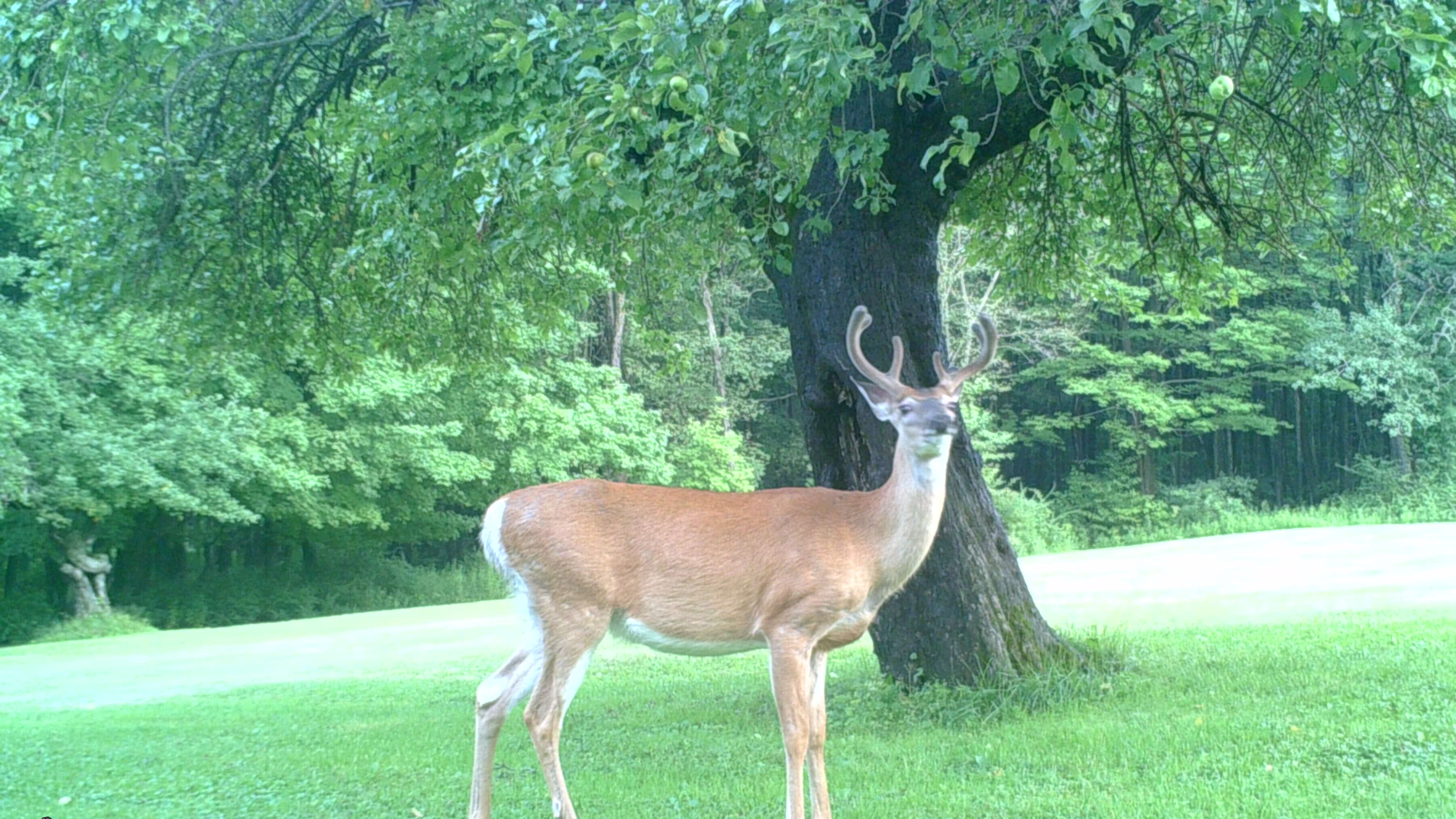
In general, this buck’s neck merges high on his chest – well above the brisket. His antler bases are relatively small and his shoulders and hams don’t appear to be fully developed. If this buck makes a living in timber habitat, I estimate he’s two. He could be a yearling if he’s been feeding on soybeans all summer.
My advice to deer hunters that wish to tag a mature buck and are faced with a quick shoot or pass decision is to focus on the buck’s chest. A mature buck’s chest will be developed and their body will have a buffalo shape. That is to say their chest will be larger than their ham. The buffalo shape is an accurate indicator that a buck is mature and is fairly easy to accurately assess in a shoot or pass hunting situation.
Enjoy Creation,
Grant
Ticks: What’s their purpose?
I was recently was asked, “What was the Creator thinking when He created ticks?”
I’ve often wondered this myself. Tick populations are increasing in the USA. Before European settlement there were large (75 mile wide) fires (either started by natural events or Native Americans) based on early explorer records. These fires likely significantly reduced tick populations (based on burning large cattle pastures in Oklahoma). These days a large prescribed fire in most places is 100 acres or less. As soon as vegetation grows in these areas deer and other herbivores forage there and ticks of various maturing stages drop of these critters. so the area is repopulated with ticks rapidly.
After a lot of thought and conversations with folks much smarter than me, I believe ticks were created to remove weak or diseased critters and their populations were kept in check by large wildfires. This is a theory based on what’s known and what I believe, as a biologist, seems plausible.
Enjoy Creation!
Grant
What Habitat Improvement Projects Should You Do?
This time of year, I’m frequently asked what habitat improvement projects are most important. Most folks expect a standard answer such as “plant a food plot” or “create some bedding cover”. These projects may or may not be appropriate for your goals or where you hunt.
Which project or projects will produce the most benefits depends on your hunting goals and what the limited/missing resource is in the local habitat. For example, if where you hunt borders a creek, lake, or several ponds that don’t go dry, developing another water source won’t improve the quality of the habitat for deer and turkeys or help you pattern deer. Likewise, if there’s a large CRP field next to where you hunt, then cover isn’t limited and adding more wouldn’t attract deer and probably won’t make them easier to pattern.
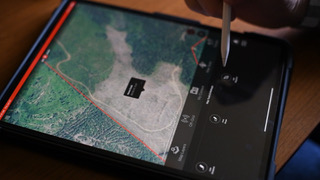 Before assisting folks with their habitat and hunting goals I start by using onX maps to study their property and the neighborhood. I also ask very detailed questions about their hunting style. These questions include how much they and others hunt the property. Understanding the amount of hunting pressure is a big factor when determining the amount of cover and the number of stands/blinds that allows the best opportunity of meeting their hunting objectives.
Before assisting folks with their habitat and hunting goals I start by using onX maps to study their property and the neighborhood. I also ask very detailed questions about their hunting style. These questions include how much they and others hunt the property. Understanding the amount of hunting pressure is a big factor when determining the amount of cover and the number of stands/blinds that allows the best opportunity of meeting their hunting objectives.
I also ask whether they primarily hunt with a gun or bow. Different habitat layouts are better for different weapons.
Likewise, I ask if they hunt throughout the season or prefer to hunt during the early, mid, or late season. Different resources attract deer during different parts of the season. The greater the difference in weather conditions throughout the season, the larger the differences of habitat resources deer need.
These are but a few considerations to address before spending valuable time and resources to improve the deer herd quality and hunting opportunities where you hunt.
Enjoy Creation,
Grant
The Trick to Aging Bucks In Summer
Many deer hunters, including myself, enjoy using trail cameras during July to see how antlers are developing and the age structure of bucks where they will be hunting.
Estimating a buck’s age during the growing season can be difficult. Bucks aren’t producing as much testosterone during this time of year and therefore they don’t appear as muscular or bulked up.
These conditions often result in estimates of bucks’ ages being younger than they are.
As an example, we recently posted a current Reconnyx image of a buck we call Ringer 8 on social media and asked for estimates of his age. This buck has displayed similar antler characteristics year to year, which has made it possible to identify him.. We have images of Ringer 8 for 4 years and feel confident he’s 8+ years old.
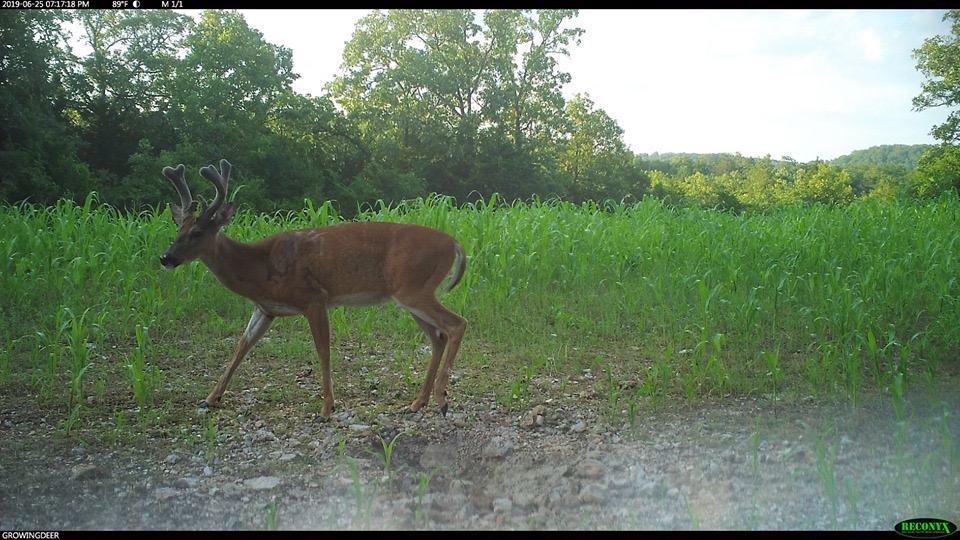
Most folks underestimated his age. They judged him to be 2 or 3 years old!
You may believe most estimates were too young because Ringer 8’s antlers are small for his age. However, we find the same trend when posting images of bucks with relatively large antlers for their age.
Most images in magazines, taxidermy, etc., show bucks during the peak of the rut when bucks’ testosterone levels are high and bucks are at their physical peak. It seems we get conditioned to expect bucks to appear in this shape year-round.
There are some physical traits that don’t change with the influx of testosterone during the early fall. Bucks with a pot belly and/or swayed back show these characteristics during the summer and fall. Another characteristic of mature bucks is that their brisket hangs below their chest during both the summer and fall.
Rather than estimating a buck’s age based on antler size, this year try studying the body characteristics. I believe your estimates will be more accurate.
Enjoy Creation and I hope our paths cross soon!
Grant
Why Hunters Should Start Scouting for Acorns Now
I’ve already started scouting where to put some stands and blinds. This may seem early to some deer hunters. However, scouting now can lead to tagging a buck during the early season.
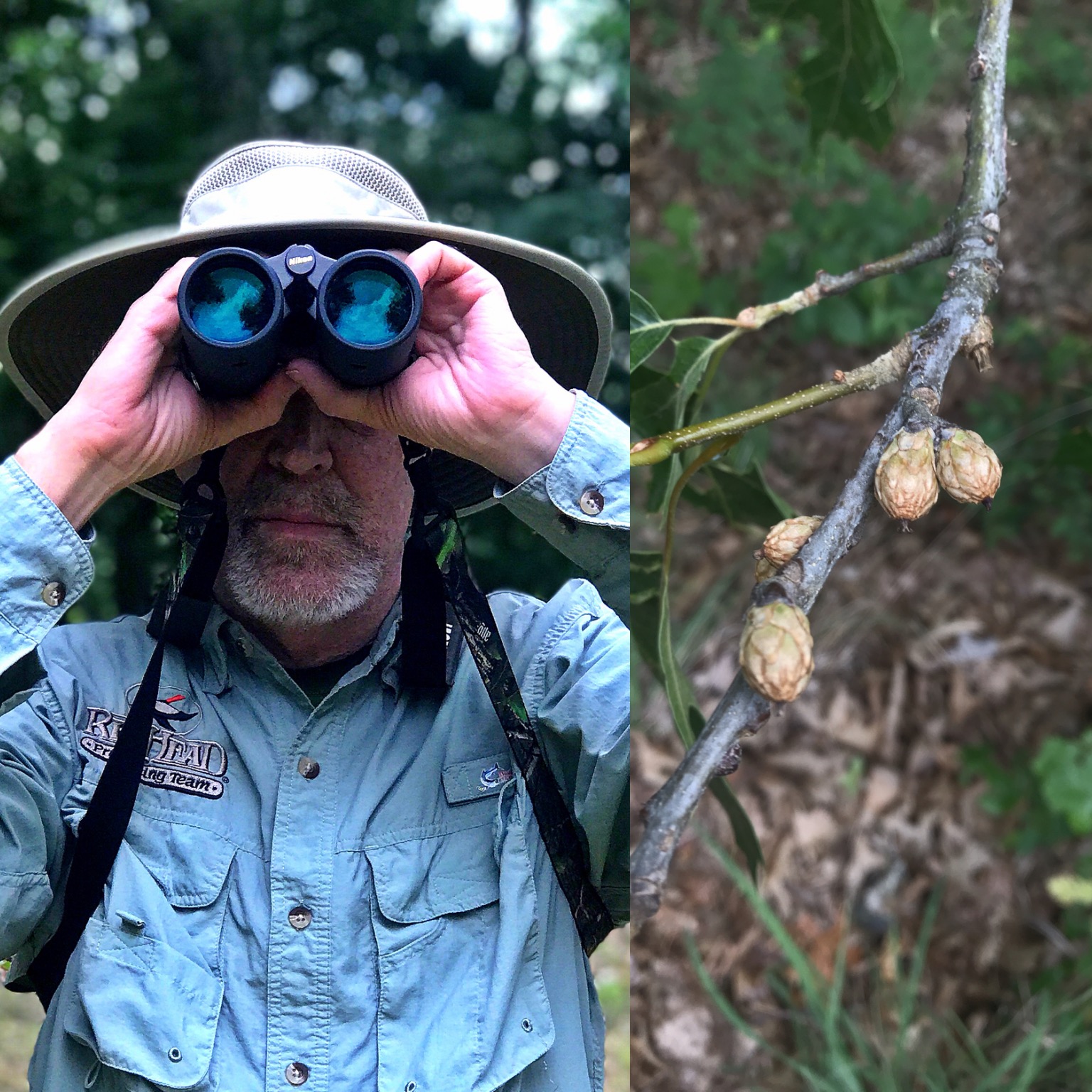
It’s been a wet year and there wasn’t a late frost at The Proving Grounds. These conditions often result in large acorn crops. Based on a bit of scouting, I’ve noticed an abundant crop of red oak acorns and a medium to large crop of white oak acorns.
The trees I’ve scouted were on the edge of food plots, roads, etc. It’s much easier to scout for acorn production in these locations this time of year as they will offer a view of at least one side that isn’t blocked by leaves of another tree.
Many species of acorns are greenish colored this time of year. It can be tough to see green acorns when looking up into a green canopy. The shapes or outlines of acorns can be spotted more easily when looking into the side of a tree’s canopy. Closer to when the acorns are ripe, they turn brown and are much easier to see when looking from below.
Trees with less competition often produce acorns more frequently and more acorns than trees surrounded by competition. In addition, acorns produced by open grown trees are often larger than trees that have a lot of competition.
Another very important factor is that acorns from open grown trees often seem to mature and drop a bit earlier than oaks growing where there’s a lot of competition. This is very important information. Where the first acorns drop is often an extremely hot spot for deer!
Most species of acorns are high energy and deer crave energy-rich foods during early fall. If there are lots of oaks producing acorns in the area, it’s much easier to find and pattern deer before acorns are present throughout the timber. Spending time now scouting oaks that are likely to drop acorns first can lead to tagging a good buck during the early season!
Enjoy Creation,
Grant



